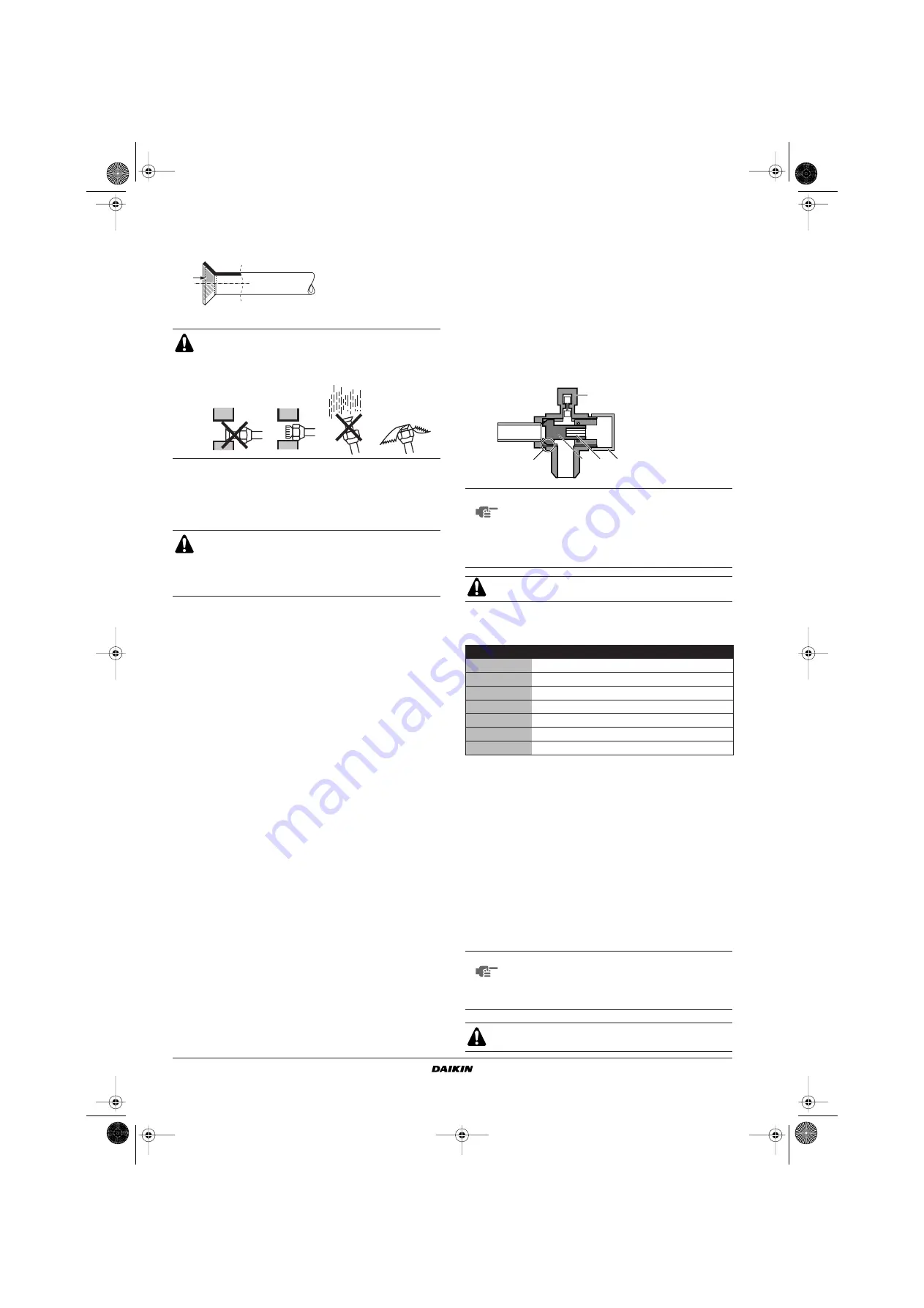
Installation manual
4
EWLP012~065KBW1N
Condenserless water-cooled water chillers
4PW61665-1 – 07.2010
■
When connecting the flare nut, coat the flare inner surface with
ether oil or ester oil and initially tighten 3 or 4 turns by hand
before tightening firmly.
■
Check the pipe connector for gas leaks.
■
The discharge and liquid line are to be connected with flare
connections to the remote condenser piping. For use of the
correct pipe diameter see
"Technical specifications" on page 1
■
piping length: equivalent
= 50 m
maximum height = 30 m
Leak test and vacuum drying
The units were checked for leaks by the manufacturer.
After connection of the piping, a leak test must be performed and the
air in the refrigerant piping must be evacuated to a value of 4 mbars
absolute by means of a vacuum pump.
Open the discharge- and liquid stop valves.
1
to open
-
Remove the cap (1) and turn the shaft (2) counterclockwise
with hexagon socket screw keys (3) (JIS B 4648 nominal size
4 mm).
-
Turn it all the way until the shaft stops.
-
Tighten the cap firmly.
2
to close
-
Remove the cap and turn the shaft clockwise.
-
Tighten the shaft firmly until it reaches the sealed area (4) of
the body.
-
Tighten the cap firmly.
Charging the unit
First perform a rough refrigerant charge according to the table:
VRC = volume of remote condenser (l)
LLP = length of liquid pipe (m)
Next perform a fine-tuning
For fine-tuning of the refrigerant charge, the compressor must
operate.
■
If the liquid-line sightglass is showing seal after the rough
charging (due to possible different conditions), add 10%
refrigerant charge weight.
■
If the liquid-line sightglass is showing some gas-bubbles, the
rough refrigerant charge is sufficient by fine-tuning the additional
10% refrigerant charge weight.
■
If the liquid-line sightglass is showing flash gas, then charge
until one of the previous situations occur. Then fine-tune with the
additional 10% refrigerant charge weight. The unit must have the
time to stabelize which means that this charging has to be done
in a smooth way.
When inserting the refrigerant piping in the wall hole, take
care not to let dust or moisture come into the piping.
Protect the pipes with a cap or seal the pipe end
completely with tape.
Make sure the pipes are filled with N
2
during welding in
order to protect the pipes against soot.
There should be no blockage (stopvalve, solenoid valve)
between the remote condenser and the provided liquid
injection of the compressor.
NOTE
■
Use a charging hose with push rod when using
the service port (5).
■
Check for refrigerant gas leakage after tightening
the cap.
■
Make sure to keep stop valve open during
operation.
Do not purge the air with refrigerants. Use a vacuum pump
to vacuum the installation.
refrigerant charge (kg)
EWLP012
0.9+(0.(VRCx0.38)
EWLP020
1.5+(0.(VRCx0.38)
EWLP026
1.7+(0.(VRCx0.38)
EWLP030
2.0+(0.(VRCx0.38)
EWLP040
2x[1.5+(0.(VRCx0.38)]
EWLP055
2x[1.7+(0.(VRCx0.38)]
EWLP065
2x[2.0+(0.(VRCx0.38)]
NOTE
Take care for contamination of the remote condenser
in order to avoid blocking of the system. It is impossible
for Daikin to control the contamination of the "foreign"
condenser of the installer. The Daikin unit has a strict
contamination level.
Use the liquid line check valve for charging refrigerant and
make sure to charge liquid.
5
1
2
3
4
4PW61665-1_digital_EN.book Page 4 Friday, August 27, 2010 2:13 PM






























